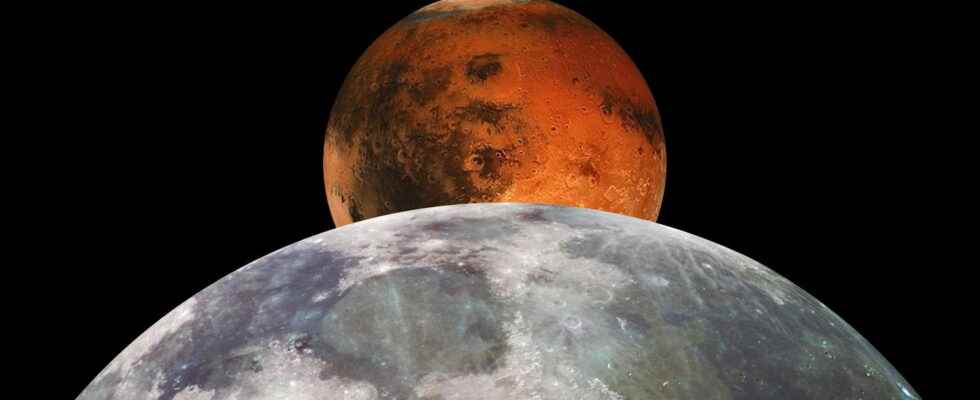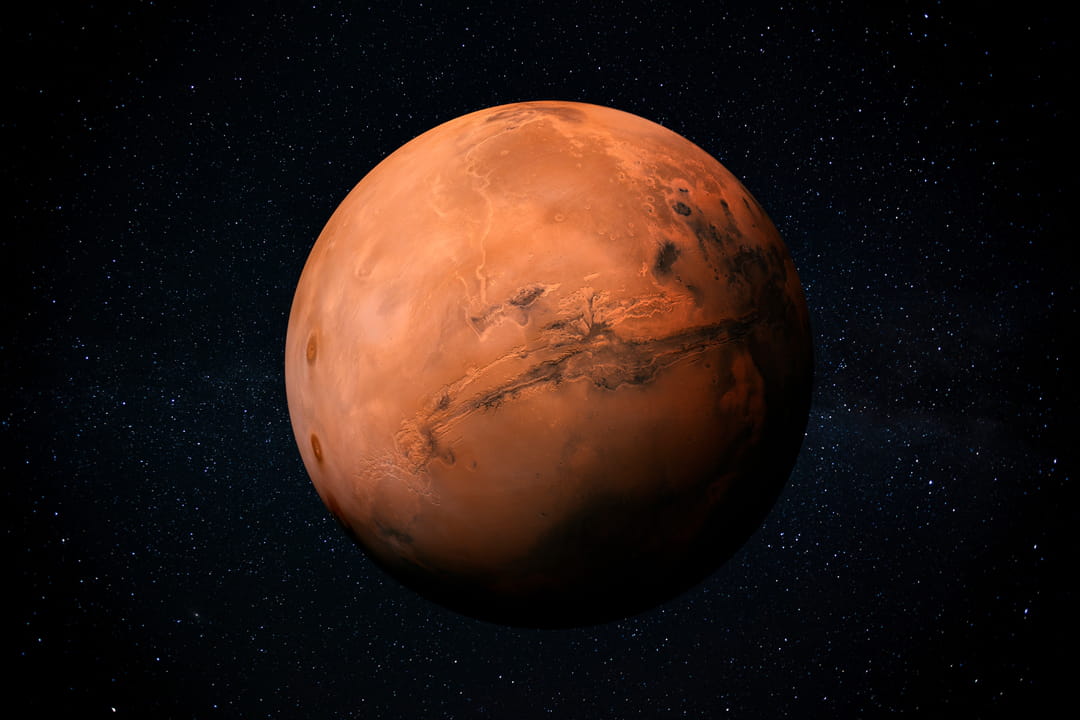MARCH. This Thursday, December 8, 2022, when the red planet will be at opposition, you will be able to witness its occultation by the Moon. Time, observation, definition, we tell you everything about this astronomical event not to be missed.
[Mis à jour le 7 décembre 2022 à 17h27] This Thursday, December 8, get ready to get up early to watch a show that hasn’t happened since 1972: the planet Mars, which is already in the very specific opposition configuration, will be eclipsed by the Moon. The latter will pass between Mars and Earth and will temporarily hide the red planet. From Earth, you can see the planet Mars disappear for an hour behind the Moon before reappearing when our natural satellite moves away. This event occurs at least once a year but this time, it is visible from Europe including France!
This astronomical phenomenon is accessible to the naked eye, in addition to being observable through a telescope or an astronomical telescope. It can also be followed online and live on the YouTube channel from the Paris observatory, especially if the weather spoils the show! Observation, time and definition of occultation and opposition phenomena… All the information you need to know below:
What time is the opposition of the planet Mars in 2022?
The opposition of the planet Mars in 2022 takes place this Thursday, December 8 at 6:41 am. The red planet will then shine in the constellation of the Bull between the two horns of this one. It will appear at sunset on the northeast horizon and reach its highest point in the sky around midnight. At that time, you will have to look in a southeasterly direction to observe it. At the time of peak opposition at 6:41 a.m., the Moon will obscure the planet Mars. The two stars will then be just above the western horizon.
Seen from Earth, the planet Mars will rise at sunset. Sun and it will set at dawn when the Sun comes out. It can therefore be observed throughout the night. In addition, Mars is moving relatively close to Earth at the start of the month. It reached its closest point to our planet on 1er December 2022 and has been slowly moving away from us since then. It therefore appears quite large in our night sky. It’s time to take out the telescopes or look up to admire the red planet with the naked eye.
Notice to the population! Mars is getting closer to Earth, the conditions for observing the red planet are becoming excellent. On December 8, it will even be masked by the Moon, it will be visible to the naked eye, a mind-blowing spectacle. What is happening? ThreadP.Laurence pic.twitter.com/ej52Yn8eyt
— Eric Lagadec (@EricLagadec) November 27, 2022
This Thursday, December 8, 2022, the occultation of Mars will begin from 6:41 a.m., Paris time. The Moon will make the red planet disappear for almost an hour. To not miss anything, it will be enough to locate the Moon which will be above the western horizon. The latter should be easily visible since December 8 will also be the date of the full moon. “In the early morning of December 8, the red planet will […] disappear from the skies, in appearance, for a little less than an hour, hidden as it will be by the lunar disc”, indicates theIMCCE.
With the naked eye, you can see Mars disappearing behind the Moon. It will be more difficult to spot when the planet emerges from the edge of the lunar disk. If you have them, you can use binoculars which will allow you to see more details. But it is with the help of a telescope with a magnification of 50 or 100 times that you will witness the most beautiful spectacle.
What is the occultation of Mars?
The occultation of Mars occurs when the trajectory of the Moon intersects that of the planet Mars. When we observe this phenomenon from Earth, we can see the Moon gradually masking the red planet until it disappears completely. Then, Mars gradually reappears as the Moon recedes. Mars occultations occur at least once a year, but they cannot always be observed from Europe. It’s a chance to be able to do it this time from France this December 8, 2022!
What is the opposition of Mars?
The opposition of Mars is a phenomenon that occurs every two years. This is a configuration in which the Earth is between the Sun and Mars. This is the best time to observe it since it is then very bright, lit by the Sun which is in front of it, behind us when we look at it. Close to the Earth, it also appears larger. Equipped with a telescope or an astronomical telescope, one can admire more details on its surface than usual.
The opposition of Mars also corresponds to an interesting window of opportunity for the space agencies which send probes to the red planet. It is indeed a time when Mars and Earth are separated by a smaller distance. This saves energy when sending space probes.
What is the distance between Earth and the planet Mars?
The distance between Earth and the planet Mars is on average 220 million kilometers. But this distance is not fixed! Indeed, depending on where each of these planets is located in their respective orbit, the distance between them can range from about 57 million kilometers to 400 million kilometers.
It is because of this variability that astronomers must calculate very precisely the ideal moment to send a probe to the red planet. Firing windows occur every 26 months and last 3 weeks.
When to observe Mars in 2022-2023?
In 2022, Mars is visible in December, when it is relatively close to Earth and in opposition. 1er December 2022, the red planet was 81.5 million kilometers from our planet. On December 8, 2022, it is a little distant, but is placed in opposition and is visible well above the horizon. It is therefore an ideal time to observe it from France.
In 2023, Mars will be visible throughout thewinter and until late spring. For the following months, it will be too close to the Sun in the sky to be observable from Earth.
What does the planet Mars look like?
Mars is the fourth planet in the solar system starting from the Sun. It is also our neighbor since it is located next to the Earth. Its radius of 3,400 kilometers makes it the second smallest planet after Mercury. It is thus almost twice as small as our planet. Its characteristic red color makes it recognizable at first glance among the 8 planets of the solar system.
On its surface, Mars can be reminiscent of our planet in certain aspects. There are cliffs, mountains, frozen deserts at the poles, but also canyons, ancient lakes and deltas, vestiges of its past. The reason for these similarities is simple: just like on Earth, it is water that has shaped the Martian landscapes, giving rise to similar geological formations.
But the comparison stops there. If the planet Mars has experienced a humid and hot climate in the past, it is revealing a completely different face today. With its particularly tenuous atmosphere, extreme temperatures and no protection against solar radiation, the planet Mars is today a cold and arid world where no form of life has yet been detected. Traces of this climatic past are however present. This is how the Perseverance rover is currently studying the Jezero crater which once housed a lake.

